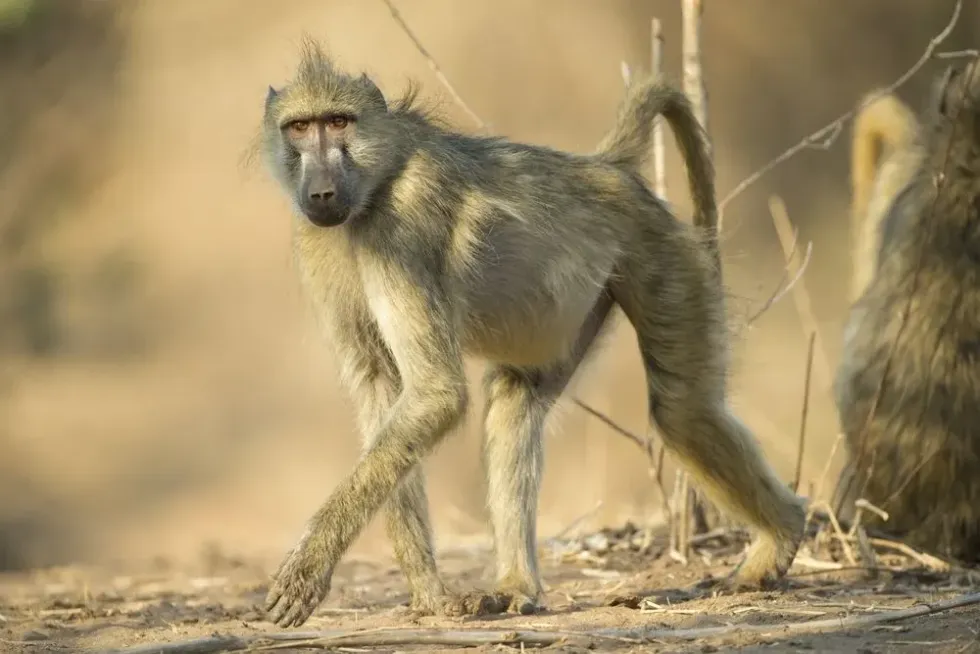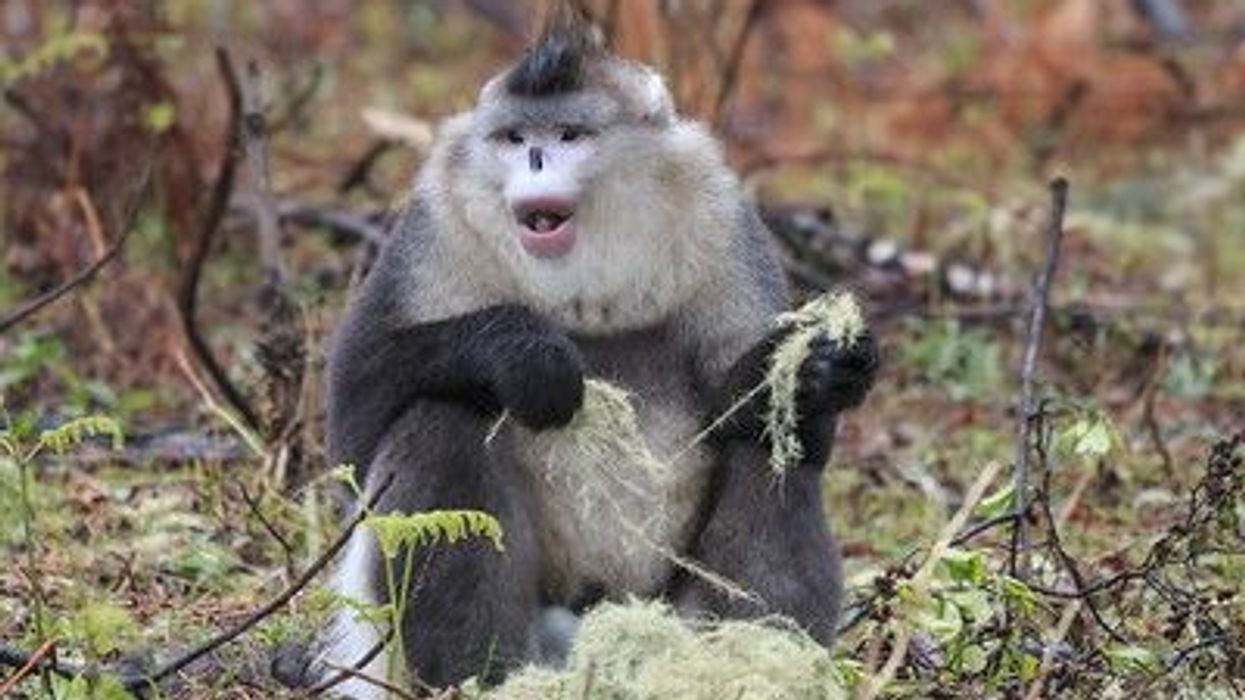The Chacma baboon (Papio ursinus) is a part of the Old World monkey superfamily. Found in the southern parts of Africa, this species of baboons are among the exotic species living in Africa. Although their population is quite stable, humans pose a threat to these animals.
These opportunistic feeders also sometimes land in the vicinity of the humans with the sole purpose of finding food. They look at the humans as the source of food, and thus, do not hesitate to attack or even mug the humans, and enter public spaces such as restaurants and even people's homes.
Given the similarities in appearance, people often get confused between the mandrills and the baboons. Formerly, both species were classified as baboons.
One of the major differences between the two species is that baboons have five different sub-species. Whereas, the mandrills do not have any sub-species. Although to many both species seem similar, in reality, there are notable differences in their physical appearance.
To learn more about these interesting animals keep reading till the end!
Are you interested in reading more such interesting articles about mysterious animals around the world? Then don't forget to check out eastern gorilla facts and capuchin monkey facts.
Chacma Baboon Interesting Facts
What type of animal is a chacma baboon?
Chacma baboons (Papio ursinus), similar to other species of baboons, are the offspring of the Old World monkey family. They belong to the 23rd genera of the Old World monkey family. Also known as the Cape baboon, these baboons are the largest of the entire monkey species.
What class of animal does a chacma baboon belong to?
Chacma baboons (Papio ursinus) belong to the Mammalia class of the Animalia kingdom.
How many chacma baboons are there in the world?
Although the exact number of chacma baboons living around the globe is unknown, it can be said that they are abundantly found throughout Southern Africa.
Where does a chacma baboon live?
This baboon species is restricted to the southern African continent. Although they are found in a vast majority, the chacma baboons are found only in a few particular countries such as Botswana, Angola, Mozambique, South Africa, Namibia, and Zambia.
What is a chacma baboon's habitat?
Grassland steppes, wooded highlands, savanna steppes, and sub deserts are among the preferred habitats for chacma baboons.
Living in diverse habitats can be difficult. However, this is where chacma baboon adaptations play a role. In order to survive, water intake is a daily need for the chacma baboons. However, they can also survive up to 20 days without actually drinking water.
Chacma baboons have cheek pouches in which they can store food. Also, they eat food with high water content to survive in water-scarce areas.
Who do chacma baboons live with?
The chacma baboons are mostly found in groups of 10 to 500 individuals. These groups are called troops. One of the main characteristics concerning the social structure of the chacma baboon troop is dominance hierarchy.
Put in simple words, the adult males and adult females have a different ranking within the troop. The position of the dominant females within the troops remains the same. Whereas, the dominant male figurine changes from time to time.
How long does a chacma baboon live?
Chacma baboons have an average lifespan of 30-45 years. However, their life expectancy reduces to 20-30 years in the wild. Studies suggest stress is among the major reasons for death among chacma baboons.
How do they reproduce?
The social organization of the species vastly influences the reproduction process. Since the troops can incorporate 10 to 500 individuals, it is more usual to have a multi-male and multi-female troop.
Thus, adult males fight with other eligible male chacma baboons to mate with the sexually receptive female baboons. In order to get access to the female, the adult male counterparts get into fierce fights.
Quite naturally, a dominant male within the troop has an upper hand in the matter. Usually, one male interacts with a number of females to find a mate.
The breeding season of the chacma baboons spans throughout the year. The reproductive cycle of the females lasts for 36 days. During this time, the posterior of the females swells and turns bright pink. Right before ovulation, the swelling reaches its peak.
After 6 months of the gestation period, the females give birth to the infants. The females and their offspring stay together in the troop until the offspring turn two years of age. After that, the male offspring leave their natal troop, in search of a new troop.
What is their conservation status?
According to the International Union for Conservation of Nature (IUCN) Red List, chacma baboons (Papio ursinus) fall under the Least Concern category. This implies that their population is stable.
Not only their population is stable but has also increased over the years. Being opportunistic animals, the chacma baboons at many times cause serious hazards to humans. It has grown to such a point that they have started to raid people's houses, even public places such as restaurants.
Chacma Baboon Fun Facts
What do chacma baboons look like?
The largest species of Old World monkeys, a chacma baboon's snout looks a lot similar to a dog's. They have large and prominent canine teeth, along with a large skull and relatively narrow upper face. Their hands and feet are comparatively longer.
Unlike other species of baboons, chacma baboons have short, coarse hair, that varies from gray to dark brown in color. While the hair on their back and limbs tend to be darker in color, their underparts and snout have a relatively lighter shade.
Even infants tend to have body hair that is comparatively of a lighter shade. Based on geographic range, their hair color varies a lot. Sub-species of the chacma baboons, named gray footed baboons, differ a lot in terms of hair color and size from these baboons.
There is a noticeable difference between the post-orbital constrictions of gray-footed baboons and chacma baboons.
How cute are they?
Although cuteness is a completely subjective matter, one will seldom find an adult chacma baboon cute. The infants, however, surely have a cute factor within them.
How do they communicate?
These animals use both visual and vocal cues to communicate with each other.
They communicate their level of anger, excitement, and arousal through facial expressions and body postures. Non-threatening behaviors associated with friendly behavior include avoiding eye contact, soft grunts, and retracting lips to show clenched teeth.
Baboons have a diverse set of vocal signals. When there is inter or intra-group aggression between males, or when a predator is nearby, the well-known 'bokkum' double bark is an alarm and aggressive signal given only by high-ranking males. Male presence and arousal are also communicated by this call.
How big is a chacma baboon?
Chacma baboons are the largest species within the monkey family. They can grow up to 20-45 in (51-114 cm) long. As compared to its sub-species, gray footed baboons, these baboons can grow 2 in (5 cm) longer.
How fast can a chacma baboon run?
These animals can run at a speed of 33.5 mph (54 kph). They use both their hands and legs to run, and similar to horses, they also gallop.
Running helps them to escape during a chase by their predators, and leopards are among their most common predators. You will be surprised to know that many times the leopards have been violently attacked and mobbed by adult males.
How much does a chacma baboon weigh?
The average bodyweight of chacma baboons falls somewhere between 33-68.3 lb (15-31 kg).
What are the male and female names of their species?
The male and female chacma baboons do not have any specific names. Thus, both the male and female counterparts of the troop are known as chacma baboons.
What would you call a baby chacma baboon?
A baby chacma baboon does not have a specific name. Therefore, they go by the name of the parent species. Thus, similar to any other species of baboons, the babies of chacma baboons are also known as infants.
What do they eat?
These animals are opportunistic omnivores. It means that they feed upon a variety of food, along with adapting to various situations. Shoots, bulbs, roots, fruit, and seeds are among their most preferred food. They also prey upon small vertebrates, invertebrates, scorpions, birds, and seashore life.
The baboon species look at humans as a source of food. Also, having humanistic characteristics makes them prone to act in a different manner with respect to other wild animals.
To address this rising concern, people have been forbidden from feeding baboons. However, tourists barely pay attention to the signs put up on the road, which in turn results in serious problems not only to them but to the natives as well.
Are they poisonous?
Although the animals are not poisonous, they can become life-threatening to not only some of the most dangerous predators in the wild but also to humans. Whenever they assume that their life is threatened, they can become extremely dangerous. Mostly the adult males within the troop take up the responsibility to protects others.
However, no matter how violent they grow, they usually don't kill humans. To date, there has just been one rare instance of a chacma baboon killing a human that has been reported.
Would they make a good pet?
No. Although some may find the younger chacma baboons to be extremely adorable, do not forget that these are wild animals.
Did you know...
Studies have proved close relation between baboons and humans. 94% of genetic similarity has been found between both humans and baboons.
What is the difference between a chacma baboon and a yellow baboon?
Although both the chacma baboon and the yellow baboon look somewhat similar, the yellow baboons are quite smaller compared to the chacma baboons. Also, the chacma baboons a more elongated muzzle, as compared to the yellow baboons.
What are the five species of baboons?
Found in various parts of Africa, the five species of baboons consist of olive baboons, chacma baboons, yellow baboons, sacred baboons, and Guinea baboons.
Olive baboons, also known as Anubis, can be found scattered in parts of Africa, starting from Kenya to Ethiopia. Although grasslands are their most preferred habitat, they can also be found in less-arid highlands.
The yellow baboons mostly inhabit savannas. They also prefer the light forests situated in the eastern part of Africa.
The sacred baboons, also known as the Arabian baboons, inhabit the open rock areas of the Red Sea coast.
Found in western Africa, Guinea baboons prefer grassy and steppe habitats.
Here at Kidadl, we have carefully created lots of interesting family-friendly animal facts for everyone to discover! Learn more about some other mammals from our mountain gorilla facts and gibbon facts pages.
You can even occupy yourself at home by coloring in one of our free printable Chacma baboon coloring pages.









